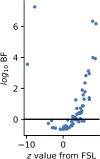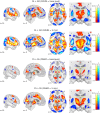Multi-study fMRI outlooks on subcortical BOLD responses in the stop-signal paradigm
- PMID: 39841120
- PMCID: PMC11753779
- DOI: 10.7554/eLife.88652
Multi-study fMRI outlooks on subcortical BOLD responses in the stop-signal paradigm
Abstract
This study investigates the functional network underlying response inhibition in the human brain, particularly the role of the basal ganglia in successful action cancellation. Functional magnetic resonance imaging (fMRI) approaches have frequently used the stop-signal task to examine this network. We merge five such datasets, using a novel aggregatory method allowing the unification of raw fMRI data across sites. This meta-analysis, along with other recent aggregatory fMRI studies, does not find evidence for the innervation of the hyperdirect or indirect cortico-basal-ganglia pathways in successful response inhibition. What we do find, is large subcortical activity profiles for failed stop trials. We discuss possible explanations for the mismatch of findings between the fMRI results presented here and results from other research modalities that have implicated nodes of the basal ganglia in successful inhibition. We also highlight the substantial effect smoothing can have on the conclusions drawn from task-specific general linear models. First and foremost, this study presents a proof of concept for meta-analytical methods that enable the merging of extensive, unprocessed, or unreduced datasets. It demonstrates the significant potential that open-access data sharing can offer to the research community. With an increasing number of datasets being shared publicly, researchers will have the ability to conduct meta-analyses on more than just summary data.
Keywords: MRI; SST; human; inhibition; neuroscience; subcortex.
© 2023, Isherwood, Kemp et al.
Conflict of interest statement
SI, SK, SM, NS, PB, BF No competing interests declared
Figures












Update of
- doi: 10.1101/2023.06.06.543900
- doi: 10.7554/eLife.88652.1
- doi: 10.7554/eLife.88652.2
- doi: 10.7554/eLife.88652.3
Similar articles
-
A supramodal role of the basal ganglia in memory and motor inhibition: Meta-analytic evidence.Neuropsychologia. 2018 Jan 8;108:117-134. doi: 10.1016/j.neuropsychologia.2017.11.033. Epub 2017 Dec 1. Neuropsychologia. 2018. PMID: 29199109 Free PMC article.
-
Comparing functional MRI protocols for small, iron-rich basal ganglia nuclei such as the subthalamic nucleus at 7 T and 3 T.Hum Brain Mapp. 2017 Jun;38(6):3226-3248. doi: 10.1002/hbm.23586. Epub 2017 Mar 27. Hum Brain Mapp. 2017. PMID: 28345164 Free PMC article.
-
Investigating Intra-Individual Networks of Response Inhibition and Interference Resolution using 7T MRI.Neuroimage. 2023 May 1;271:119988. doi: 10.1016/j.neuroimage.2023.119988. Epub 2023 Mar 1. Neuroimage. 2023. PMID: 36868392
-
Cerebellar Contributions to Proactive and Reactive Control in the Stop Signal Task: A Systematic Review and Meta-Analysis of Functional Magnetic Resonance Imaging Studies.Neuropsychol Rev. 2020 Sep;30(3):362-385. doi: 10.1007/s11065-020-09432-w. Epub 2020 Mar 18. Neuropsychol Rev. 2020. PMID: 32189178
-
Meta-analysis of real-time fMRI neurofeedback studies using individual participant data: How is brain regulation mediated?Neuroimage. 2016 Jan 1;124(Pt A):806-812. doi: 10.1016/j.neuroimage.2015.09.042. Epub 2015 Sep 28. Neuroimage. 2016. PMID: 26419389 Review.
Cited by
-
Neuroanatomical Changes in the Stopping Network Across the Adult Lifespan Assessed With Quantitative and Diffusion MRI.Hum Brain Mapp. 2025 Jun 1;46(8):e70240. doi: 10.1002/hbm.70240. Hum Brain Mapp. 2025. PMID: 40470689 Free PMC article.
References
-
- Alegre M, Lopez-Azcarate J, Obeso I, Wilkinson L, Rodriguez-Oroz MC, Valencia M, Garcia-Garcia D, Guridi J, Artieda J, Jahanshahi M, Obeso JA. The subthalamic nucleus is involved in successful inhibition in the stop-signal task: a local field potential study in Parkinson’s disease. Experimental Neurology. 2013;239:1–12. doi: 10.1016/j.expneurol.2012.08.027. - DOI - PubMed
-
- Alkemade A, Mulder MJ, Groot JM, Isaacs BR, van Berendonk N, Lute N, Isherwood SJ, Bazin P-L, Forstmann BU. The Amsterdam Ultra-high field adult lifespan database (AHEAD): A freely available multimodal 7 Tesla submillimeter magnetic resonance imaging database. NeuroImage. 2020;221:117200. doi: 10.1016/j.neuroimage.2020.117200. - DOI - PubMed
-
- Andraszewicz S, Scheibehenne B, Rieskamp J, Grasman R, Verhagen J, Wagenmakers EJ. An introduction to bayesian hypothesis testing for management research. Journal of Management. 2015;41:521–543. doi: 10.1177/0149206314560412. - DOI
Publication types
MeSH terms
Grants and funding
LinkOut - more resources
Full Text Sources
Medical

